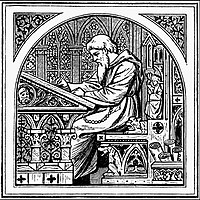
Back Portaal:Skryfstelsels Afrikaans بوابة:كتابة Arabic دەروازە:نووسین CKB Portail:Écriture French პორტალი:დამწერლობა Georgian ද්වාරය:ලේඛන කලාව Singhalese
Welcome to the writing portal
Introduction

Writing is the act of creating a persistent representation of human language. A writing system uses a set of symbols and rules to encode aspects of spoken language, such as its lexicon and syntax. However, written language may take on characteristics distinct from those of any spoken language.
Writing is a cognitive and social activity involving neuropsychological and physical processes. The outcome of this activity, also called "writing", and sometimes a "text", is a series of physically inscribed, mechanically transferred, or digitally represented symbols. The interpreter or activator of a text is called a "reader".
In general, writing systems do not constitute languages in and of themselves, but rather a means of encoding language such that it can be read by others across time and space. While not all languages use a writing system, those that do can complement and extend the capacities of spoken language by creating durable forms of language that can be transmitted across space (e.g. written correspondence) and stored over time (e.g. libraries or other public records). Writing can also have knowledge-transforming effects, since it allows humans to externalize their thinking in forms that are easier to reflect on, elaborate on, reconsider, and revise. (Full article...)
Selected article
Journalism is the practice of investigation and reporting of events, issues and trends to a broad audience in a timely fashion. Though there are many variations of journalism, the ideal is to inform the intended audience. Along with covering organizations and institutions such as government and business, journalism also covers cultural aspects of society such as arts and entertainment. The field includes editing, photojournalism, and documentary.
Johann Carolus's Relation aller Fürnemmen und gedenckwürdigen Historien, published in 1605 in Strassburg, is often recognized as the first newspaper. The first successful English daily, the Daily Courant, was published from 1702 to 1735.[1]
In modern society, news media have become the chief purveyor of information and opinion about public affairs; but the role and status of journalism, along with other forms of mass media, are undergoing changes resulting from the Internet. (Full article...)
Selected picture
Selected biography
Schmandt-Besserat has worked on the origin of writing and counting, and the nature of information management systems in oral societies. Her publications on these subjects include:
- Before Writing (2 vols), University of Texas Press 1992;
- How Writing Came About, University of Texas Press 1996;
- The History of Counting, Morrow Jr. 1999;
- When Writing Met Art (University of Texas Press, 2007); and
- numerous articles in major scholarly and popular journals among them Science, Scientific American, Archaeology, American Journal of Archaeology, and Archaeology Odyssey.
Her work has been widely reported in the public media (Scientific American, Time, Life, New York Times, The Washington Post, Los Angeles Times, Christian Science Monitor.) She was featured in several television programs such as Out of the Past (Discovery Channel), Discover (Disney Channel); The Nature of Things (CBC), Search for Solutions (PBS), and Tell the Truth (NBC).
In her most recent book, When Writing Met Art (2007), Schmandt-Besserat investigated the impact of literacy on visual art. She showed that, before writing, art of the ancient Near East mostly consisted of repetitive motifs. But, after writing, conventions of the Mesopotamian script, such as the semantic use of form, size, order and placement of signs on a tablet was applied to images resulting in complex visual narratives. She also shows how, reciprocally, art played a crucial role in the evolution of writing from a mere accounting system to literature when funerary and votive inscriptions started to be featured on art monuments. (Full article...)
Did you know...
Categories

Writing • Calligraphy • Penmanship • Writing implements • Inks • Alphabetic writing systems • Abjad • Abugida • Kanji • Logographic writing systems • Writing systems • Cyrillic alphabets • Hellenic scripts • Script typefaces
Major topics
• Calligraphy •
Western calligraphy • Islamic calligraphy • Indian calligraphy • Chinese calligraphy • Korean calligraphy • Japanese calligraphy • Persian calligraphy • Manuscript
• Writing instruments •
Pen • Ink brushes • Inks • Ink stone • Qalam • Quill • Dip pen • Nib • Paper • Writing slate • Pencil • Typewriter • Word processor • Dry erase marker • Touchscreen
Things you can do
 |
Here are some tasks awaiting attention:
|
WikiProjects
Related portals
Associated Wikimedia
The following Wikimedia Foundation sister projects provide more on this subject:
-
Commons
Free media repository -
Wikibooks
Free textbooks and manuals -
Wikidata
Free knowledge base -
Wikinews
Free-content news -
Wikiquote
Collection of quotations -
Wikisource
Free-content library -
Wikispecies
Directory of species -
Wikiversity
Free learning tools -
Wikivoyage
Free travel guide -
Wiktionary
Dictionary and thesaurus
References













